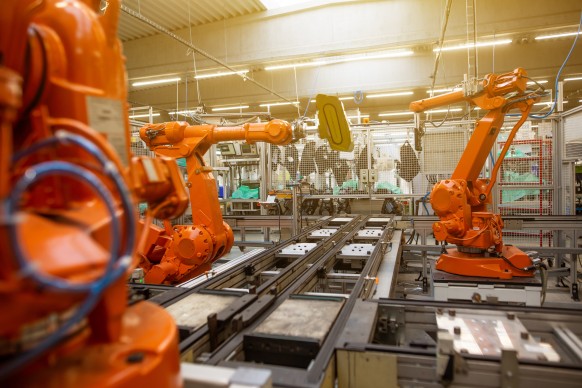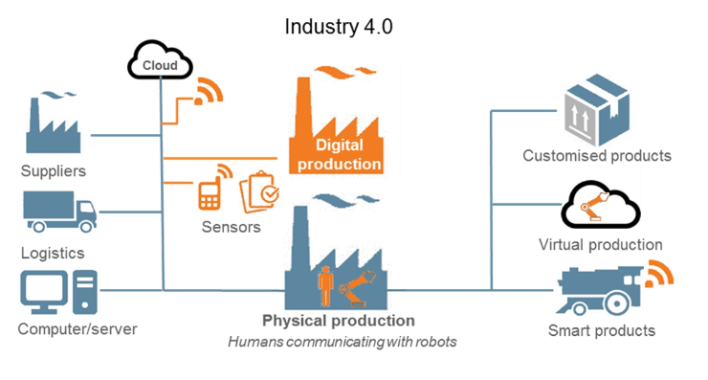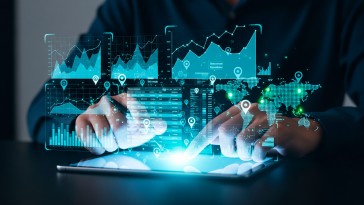Blog / Disruptive Technologies
The 7 Pillars of Industry 4.0 in Manufacturing Environments
Categories

Industry 4.0 is inherently a decentralized system, with intelligence in independent entities.
Therefore, when we talk about Industry 4.0, factory automation is structured hierarchically in the form of an “automation pyramid,” in which each level performs special functions. Individual devices/systems are attributed to individual levels.
The main goal for the development of decentralized automation concepts and systems is to achieve flexibility in factory automation systems, driven by ever more rapidly changing production conditions.
Hence, the value promised by decentralized automation concepts mainly resides in the improvement of operative parameters of a plant, for instance, through more flexibility of usage, higher efficiency, or availability.
In a typical Industry 4.0 application in a manufacturing environment, we can recognise some basic technologies, which are called the “pillars” of Industry 4.0.
First things first: what is industry 4.0?
Industry 4.0 represents the fourth industrial revolution, marking a pivotal shift in the way we perceive and operate within the industrial landscape.
It is a fusion of digital technologies and physical systems, enabling a new era of automation, connectivity, and data-driven decision-making.
Industry 4.0 encompasses a vast array of transformative technologies that are reshaping the global manufacturing and production processes.
In this article we’ll check them out.
What is Industry 4.0 Manufacturing?
Industry 4.0 Manufacturing signifies the integration of advanced digital technologies into the entire manufacturing process, resulting in a highly interconnected, intelligent, and automated ecosystem.
These technologies enable real-time data collection, analysis, and decision-making, driving improvements in productivity, quality, and customization.
With Industry 4.0 Manufacturing, manufacturers can embrace the power of digital transformation to stay competitive, enhance operational efficiency, and deliver innovative products and services in the ever-evolving global market.

What are the defining characteristics of industry 4.0?
Integration of Cyber-Physical Systems
Advanced Data Analytics
Cloud Computing and Big Data
Automation and Robotics
Customization and Personalization
Decentralized Decision-making
Sustainable and Green Manufacturing
What is industry 4.0 technology?
Industry 4.0 technology refers to a collection of advanced digital tools and systems that are revolutionizing the manufacturing landscape.
Let’s check them out!
1. The Internet of Things
The basic requirements of Industry 4.0 concern interoperability and information transparency.
To this purpose, every application in a manufacturing environment normally is based on a network - or cloud - of interconnected objects (sensors, actuators, PLCs, computers, etc.) that are able to exchange data and information.
Such a network is called the Internet of Things (IoT), where every object (or ‘thing’) is provided with a processing capability and an interface that makes it a CPS or Cyber-Physical System.
As the phrase “Internet of Things” reveals, the IoT paradigm will provide a technological universe, in which many physical objects or “things”, such as sensors, everyday tools and equipment enhanced by computing power and networking capabilities will be able to play a role, either as single units or as a distributed collaborating swarm of heterogeneous devices.
The structure of IoT is based on three layers; namely, the perception layer (sensing), the network layer (data transfer), and the application layer (data storage and manipulation).
Despite great improvements, IoT is still evolving, trying to obtain its final shape. Networking capability is one of the core features of the IoT devices.
2. Big Data
Big Data are high-volume, high-speed and / or high-variety information resources that require convenient and innovative forms of information processing that allow for better understanding. situation, more efficient decision making and intelligent process automation.
From an IT perspective, the term Big Data refers to a data set that is too large or too complex to be processed by normal computing devices. As such, it relates to the computing power available on the market.
According to another definition, Big Data is data that exceeds the processing capacity of conventional database systems. The data is too large, moving too fast, or does not fit into the structures of the database architectures. To get value from this data, it is therefore necessary to find an alternative way to process it.
Large volumes of structured, semi-structured and unstructured data, acquired from a variety of heterogeneous sources, fall into the category of Big Data. This data is typically assumed to contain valuable hidden information, requiring substantial effort and resources to uncover it.
Big Data analytics helps businesses leverage their data and use it to identify new opportunities. This, in turn, leads to smarter business decisions, more efficient operations, higher profits, and happier customers.
3. Artificial intelligence (AI)
AI can be described as 'the science and engineering of manufacturing intelligent machines and programs'. So, it is a way to make a computer, a robot or a software decide as a human being would.
For this purpose it is necessary to study the way in which the human brain thinks and the way in which humans learn, decide and work while trying to solve a problem, thus using the results of this study as a basis for software and systems development.
The artificial intelligence demonstrated by machines is however different from human intelligence and its implementation opens a world of new opportunities for programmers, who can create applications in very different domains: from industrial production, to cybersecurity, to energy management. and so on.
Therefore, before learning the basics of artificial intelligence, it is essential to understand that it is above all a combination of reasoning, planning and problem solving skills. Languages like Python, R, Lisp, Java, and Prolog are just some of the many languages that can be used for AI programming and creating innovative projects.
4. Communication technologies
At field level, the tendency now is to use a connection system common to all the devices composing the automation system which can be accessed by all of them for data communication: the so-called fieldbus.
The fieldbus is a special network (bus) that can be used in an industrial environment (field) to interconnect sensors, drives, controllers and other devices equipped with a special interface within a plant or a machine. Other fieldbus technologies are specialized for applications in buildings, cars, etc. In this way, the connected units can freely exchange information using a simple low cost support (a cable or a wireless link) and a special protocol.
The analogy with office LANs stops here, because the data traffic in the fieldbus has different characteristics: the messages transmitted on the field are generally very simple, very frequent and must reach their destination in a very short and determined time, so that the control systems can give a real-time response to critical events. On the other hand, in an office environment, the determinism and the short response time are not crucial.
5. Autonomous robots
Long used to tackle complex tasks, robots provide an ever wider range of services and are becoming more autonomous, flexible, and cooperative. They will interact with one another and work safely with humans (the term “cobotics” is used to describe robots helping operators perform their tasks).
Eventually, they will be able to learn from humans.
Collaborative robots (cobots) have a key role in current and future trends in industrial automation and production. With the average retail price of a cobot continuously decreasing, their use in this type of automation is also becoming increasingly feasible for industrial manufacturing applications in smaller facilities and warehouses.
However, companies that are developing innovative and integrated cobot concepts must meet a wide range of requirements. To increase production flexibility, efficiency and quality, they will need to carefully develop the interaction between mobile robots, cobots and other elements – such as integrated apps, support and risk assessment, and camera and vision technology.
6. Cybersecurity
The days of closed, unconnected operational management systems are over.
Connectivity and communication protocols are becoming the norm.
Protecting information systems and manufacturing lines from cybercrime threats is becoming a critical issue.
Sophisticated identity and machine access management systems will be used to provide secure, reliable communications.
The smart factory’s combination of virtual and physical systems makes interoperability and real-time capability possible, but it comes with the cost of an expanded attack surface that requires both IT and OT defenses. Organizations must carefully consider the security implications to have a successful Industry 4.0 journey.
7. Additive manufacturing
Companies have just begun to adopt 3D printing for prototyping and unit production.
With Industry 4.0, these technologies will be chosen for their very high performance in producing small batches of customized products.
Decentralized systems will reduce transportation and inventory management costs.
The significant price reduction of digital scanners and 3D printers enables much faster prototyping of products/product development. A few large companies are now looking to use 3D printing in production, allowing more complex parts to be made in significantly less time.
Additive manufacturing produces less waste. Since the cost and time of prototyping are lower by 3D printing, you can produce, test and make the necessary changes without too much trouble. Traditional manufacturing processes can not handle complex designs and require multiple production steps. This increases both material and labor costs and the time required to create and assemble the different parts.
Conclusion: the importance of mastering industry 4.0 solutions
To make the practical implementation of Industry 4.0 possible, some basic (“pillar”) technologies are required. Some of them, like the fieldbus technologies, are not brand new, while some others, like the additive manufacturing, were introduced more recently. All together, they are enabling what we call the Fourth Industrial Revolution in any kind of manufacturing.
How to implement industry 4.0 and master digital transformation?
To effectively implement Industry 4.0 and navigate digital transformation, consider pursuing our Global MBA in Digital Transformation. This specialized program equips you with strategic insights, technical expertise, and managerial skills to drive organizational change. The programme covers digital strategy, data analytics, emerging technologies, and innovation, and prepares you to lead in the age of Industry 4.0.




